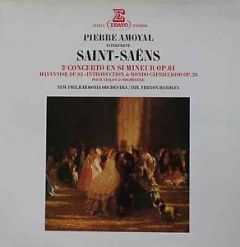Camille Saint-Saens – Violin Concerto No.3 h-moll Op.61 (1977)
Camille Saint-Saens – Violin Concerto No.3 h-moll Op.61 (1977)

I. Allegro non troppo 8:53 play II. Andantino quasi allegretto 7:59 III. Molto moderato e maestoso; Allegro non troppo 10:48 Pierre Amoyal - violin New Philharmonia Orchestra Vernon Handley – conductor
Saint-Saëns composed a number of concertos, among them two for cello, five for piano, and three for violin. As he had the Violin Concerto in A major, Op. 28 (1859), and the Introduction and Rondo capriccioso, Op. 28 (1863), Saint-Saëns composed the Violin Concerto No. 3 in B minor, Op. 61, for the virtuoso violinist Pablo de Sarasate (1844-1908). Sarasate gave the first performance of the work at one of the composer's many Monday soirées in 1880, the year Saint-Saëns completed the piece.
As in all the pieces Saint-Saëns composed for Sarasate, the Violin Concerto No. 3 frequently allows the soloist to display technical prowess; however, the piece requires refined musicality, as well. The Third Concerto stands out among Saint-Saëns' works in the genre because it reverts to a format with three clearly separated movements.
The concerto begins without an orchestral introduction; instead, only quietly rumbling chords that provide a harmonic background for the harsh violin theme can be heard. As the first movement progresses, it reveals itself as a very dramatic essay, contrasting passionate, effusive sections with more gentle passages. With a basic outline of sonata form, the movement features a first theme that conveys a sense of yearning and searching through numerous accents and an apparent lack of direction. After a few flashy flourishes from the soloist, the full orchestra powerfully re-states parts of the main theme, creating a transition to the contrasting, lyrical secondary theme. Fragmentation and thematic transformation propel the movement toward a rousing conclusion.
For the second movement, Saint-Saëns composed a barcarolle in which the violin and woodwinds exchange material. The key, B flat major, is striking in that it is a half step below that of the first movement. The melodies are Italianate in this 6/8 time movement, marked Andantino quasi Allegretto. Judging from Sarasate's own compositions, the second movement of Saint-Saëns' concerto is well suited to the violinist's elegant style. The excellent close features a violin line of harmonics that climbs to the stratosphere and seems to disappear.
Surprisingly, a slow introduction, which one might expect to open the first movement of a symphony or concerto, precedes the finale. Marked Molto moderato e maestoso, the introduction, with its coarse violin part alternating with busy orchestral passages, avoids the key of the movement, B minor. After reaching the dominant, the tempo shifts to Allegro non troppo and the movement begins. Throughout the finale, the orchestra is more involved in the musical argument than it is in the previous movements. The opening, leaping theme with triplets contrasts with a rising scale that is the secondary idea, and at the center of the movement can be heard an elegant, cantabile section in G major in which the orchestra takes a leading role. Occasionally the movement takes on a "gypsy" flavor before a return of the leaping theme leads to a change to B major, a brief, chorale-like passage for the orchestra and flashy conclusion in the new key. ---John Palmer, Rovi
download: uploaded yandex 4shared mediafire solidfiles gett mega zalivalka filecloudio anonfiles oboom ziddu
Zmieniony (Wtorek, 22 Kwiecień 2014 10:21)








